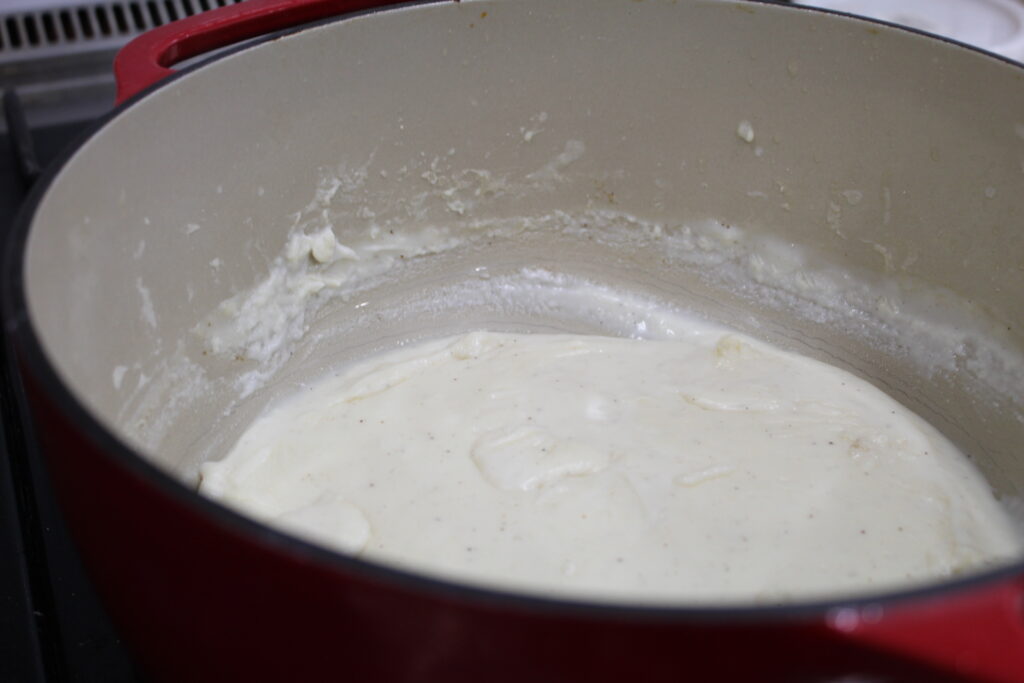Try one of the other five French Mother Sauces

Béchamel is the quintessential French white sauce used not only in a host of classic French cuisine, but also as a base for other white sauces. There’s a common misconception that French sauces, such as Béchamel, are rich in cream and heavy with fat but that’s not really true, as the ingredients for classic Béchamel demonstrate
- 2 TBL butter
- 2 TBL flour
- 1/8 tsp salt and a dash of pepper
- 1 cup milk (2% if you have it)
- pinch of nutmeg (optional)
The key to good Béchamel, as with most French sauces, lies in making the roux. In French cooking, roux is still a very common technique that cooks flour in butter to bring out the flour’s nutty flavor and to give the sauce character. When done right, a roux based sauce should not require adding starch at the end as is common with most gravies. Keep in mind French sauces are not the same as the gravies you’re used to making.
- Make the roux: On medium heat, melt butter in a medium sauce pan. Once the butter is melted, stir in flour. This step is the one that determines the sauce’s end state. The goals when cooking flour in butter are to unlock the flour’s nutty flavor and to provide both color and texture to the finished sauce. Since Béchamel is a white sauce, be careful not to overcook the roux or it will brown. You’ll know the roux is ready for milk when it becomes silky smooth with the desired color.
- Add the milk: While stirring the roux, slowly add milk in stages. As soon as you add the first portion of milk the roux will suddenly thicken. Don’t worry about this, just keep slowly adding milk as you stir and it will loosen up. You want to slowly loosen the roux to prevent the sauce from having lumps, i.e., add milk too fast and you’ll get a lumpy sauce. Once all the milk has been added, bring sauce to boil making sure to stir frequently.
- Simmer the sauce: As soon as the sauce begins to boil, reduce heat to a simmer and allow the sauce to thicken. For me this is the tricky part of a good French sauce. I usually end up hurry my sauces due to starting too late in the meal prep process, then I’m tempted to add starch to thicken quickly. I encourage you to resist the temptation and let the sauce simmer down to a thickened state relying on the roux to provide the binding agents. While the sauce is simmering add salt and pepper to taste. It’s a good idea to add both gradually, a little at a time, tasting between additions. It can take a few moments for the sauce to acquire it spice profile but if you over spice, your screwed. The goal in French sauces is to have the salt awaken the taste profile without being dominate. It seems to me that most gravies are over salted.
Note 1: Old school French chefs use a gas range to make sauce, but I’ve found that the counter top induction stove I bought for $100 gives me better sauce making control. Note 2: American gravies tend to be over-salty while a well made French sauce has just enough salt to awaken the pallet without having it dominate. Note 3: If I’m cooking Keto, I substitute heavy cream for the milk. In keto diets, milk is taboo because of its sugar while heavy cream is a plus for its fat. If you substitute heavy cream for milk, you’ll probably have to cook the roux longer due to the extra butter fat in the cream. Be careful not to burn the roux or darken the cream more than you are looking for in the final sauce.

